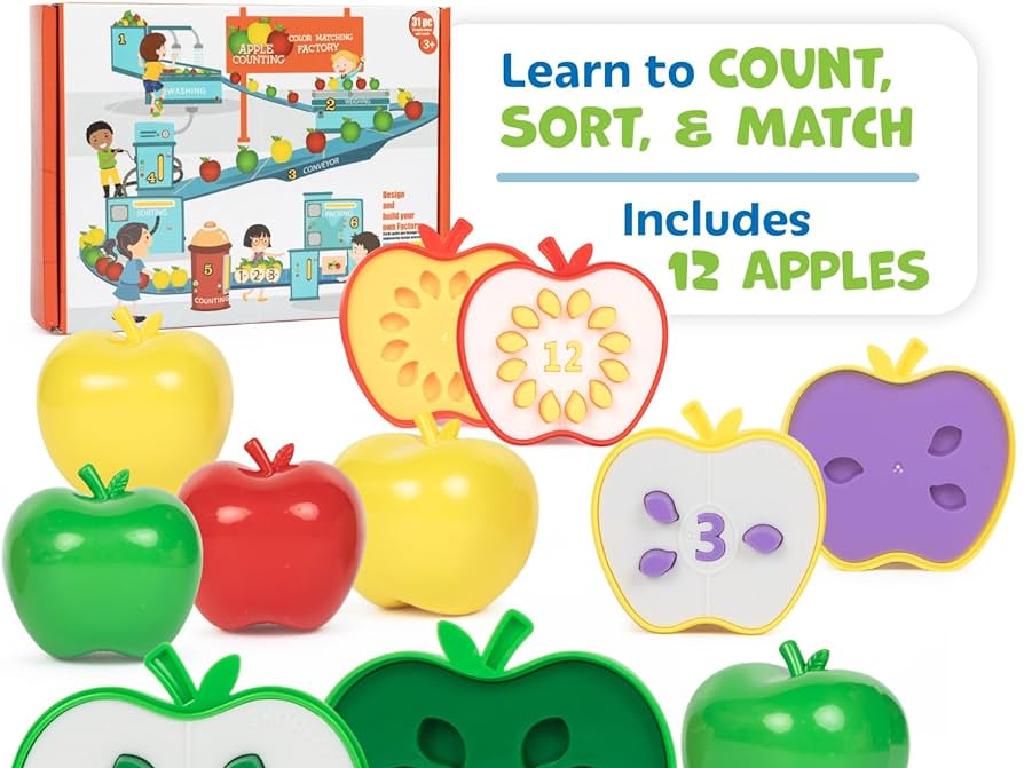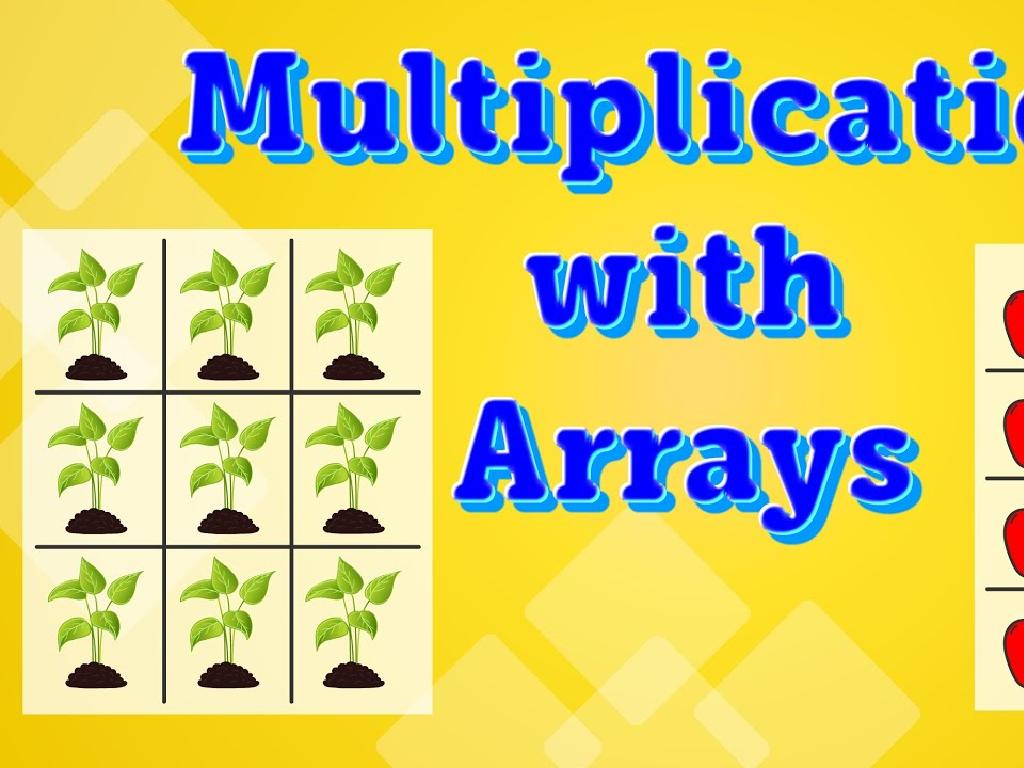Multiply A Whole Number By A Power Of Ten
Subject: Math
Grade: Fifth grade
Topic: Multiplication
Please LOG IN to download the presentation. Access is available to registered users only.
View More Content
Multiplying by Powers of Ten
– Review basic multiplication
– Multiplication in daily life
– Used in shopping, cooking, and time management
– Multiply by powers of ten
– 10, 100, 1000 are ‘powers of ten’
– Practice with examples
– Example: 5 x 10 = 50, 5 x 100 = 500
|
Begin with a quick review of basic multiplication to ensure all students are on the same page. Emphasize the role of multiplication in everyday scenarios such as calculating total cost while shopping, doubling a recipe in cooking, or planning time. Introduce the concept of multiplying by powers of ten, explaining that these are simply numbers like 10, 100, and 1000. Demonstrate how multiplying by these numbers shifts the digits to the left, making the number larger. Provide clear examples, such as multiplying 5 by 10 and by 100, to illustrate the concept. Encourage students to think of other examples and to practice this skill with different numbers to gain confidence.
Multiplying by Powers of Ten
– Define power of ten
– A power of ten is 10 raised to any whole number exponent.
– Examples: 10, 100, 1000
– 10^1=10, 10^2=100, 10^3=1000, and so on.
– Relate to place value
– Each power of ten shifts the digits to the left by one place.
– Practice multiplication
– Multiply 5 by 10, 100, and 1000 to see the pattern.
|
Begin by explaining that a power of ten is simply the number 10 multiplied by itself a certain number of times, determined by the exponent. Show examples of powers of ten to help students recognize the pattern. Connect this concept to place value by demonstrating how multiplying by a power of ten moves each digit to a higher place value, effectively ‘shifting’ the digits to the left. Provide practice examples, such as multiplying single-digit numbers by 10, 100, and 1000, to reinforce the concept. Encourage students to observe the pattern that emerges when they multiply numbers by powers of ten.
Multiplying by Powers of Ten
– Understanding the shift with x10
– Each digit moves one place to the left when we multiply by 10.
– Example: 23 x 10 = 230
– Notice how 23 becomes 230, adding a zero to the end.
– Class practice problem
– Let’s solve a problem together to practice this concept.
|
This slide introduces the concept of multiplying whole numbers by 10. Emphasize to students that when we multiply by 10, each digit in the number shifts one place value to the left, effectively adding a zero to the end of the number. Use the example provided to illustrate this point. After explaining the concept, engage the class with a practice problem where they can apply what they’ve learned. This could be a simple multiplication problem like 46 x 10. Walk through the problem with the class, asking for volunteers to explain the process. This interactive approach helps solidify the concept and prepares students for more complex problems involving powers of ten.
Multiplying by 100
– Understanding the shift when multiplying by 100
– Each digit moves two places to the left.
– Example: 46 x 100 = 4600
– Notice how 46 becomes 4600, adding two zeros.
– Let’s practice together!
– Solve 23 x 100 as a class.
|
This slide is focused on teaching students the concept of multiplying a whole number by 100. Emphasize that when we multiply by 100, each digit in the original number moves two places to the left, which is the same as adding two zeros to the end of the number. Show the example on the slide and explain step by step how the digits shift. After the example, engage the class with a practice problem, such as 23 x 100, and solve it together. Encourage students to explain the process in their own words to reinforce their understanding. This exercise will help solidify the concept of place value and the base-ten system in the context of multiplication.
Multiplying by 1000
– Understanding the shift by 1000
– Each digit moves three places left when multiplied by 1000.
– Example: 89 x 1000
– 89 becomes 89000, shifting each digit three places to the left.
– Practice problem together
– Let’s solve a problem as a class to practice this concept.
|
This slide is focused on teaching students the concept of multiplying a whole number by 1000. Emphasize that when we multiply by 1000, each digit in the original number moves three places to the left, and we fill in with zeros. Show the example of 89 x 1000 to illustrate this point. After explaining the concept, engage the class with a practice problem. For example, ask them to multiply 54 by 1000. Walk through the problem step by step, ensuring that students understand the process of shifting digits. Encourage students to explain the process in their own words to assess understanding. Provide additional practice problems for homework to reinforce the concept.
Patterns in Multiplying by Powers of Ten
– Spot patterns in results
– Observe how zeros increase in products
– Consistent place value shifts
– Each power of ten shifts digits left
– Group activity on patterns
– Work together to find patterns using various numbers
– Importance of power of ten
|
This slide introduces students to the concept of multiplying whole numbers by powers of ten and the patterns that emerge from such multiplication. Emphasize the predictability of the process, where each increase in the power of ten adds a zero to the product, effectively shifting the place value of the original number to the left. During the group activity, students will collaborate to multiply different whole numbers by 10, 100, and 1000, observing the consistent shift in place value. This activity will help solidify their understanding of the concept through hands-on practice. Provide guidance on how to organize their findings and encourage discussion about why these patterns occur. The goal is for students to recognize the power of ten as a building block in our number system and its role in simplifying multiplication.
Multiplying by Powers of Ten: Real-World Applications
– Understanding money calculations
– E.g., $2 to $20 by multiplying by 10
– Measuring distances and weights
– Kilometers to meters, grams to kilograms
– Counting large quantities
– Items in boxes, people in cities
– Exploring everyday applications
|
This slide aims to show students how multiplying by powers of ten is a practical skill used in daily life. When dealing with money, such as increasing an amount tenfold, this concept is directly applied. Measurements often require shifting between units (like meters to kilometers), which involves multiplying or dividing by powers of ten. Counting items, especially in large quantities, is simplified by understanding this concept. Engage the class in a discussion to identify other areas where they encounter multiplication by powers of ten, such as in time (seconds to minutes), data storage (bytes to kilobytes), or population studies. This will help students see the relevance of what they learn in math class to the world around them.
Class Activity: Multiplication Relay
– Teams solve power of ten problems
– Each team tackles multiplication
– First team with correct answers wins
– Encourages teamwork and speed
|
Divide the class into small groups, assigning each team a set of multiplication problems that involve multiplying whole numbers by powers of ten. This activity is designed to reinforce the concept of place value and the ease of multiplying by 10, 100, 1000, etc. Ensure that each team understands the rules: they must work together to solve each problem, and only correct answers count towards completion. The first team to finish with all correct answers will be declared the winner. This activity promotes not only mathematical skills but also teamwork and collaborative problem-solving. Possible variations of the activity could include a relay race where students take turns solving problems, or a ‘beat the clock’ challenge where teams compete to finish before a timer runs out.
Review and Homework: Multiplying by Powers of Ten
– Summarize today’s multiplication lesson
– Address any unanswered questions
– Homework: Multiplication worksheet
– Complete the provided worksheet on multiplying whole numbers by powers of ten.
– Practice with powers of ten
– Focus on multiplying by 10, 100, and 1000.
|
As we wrap up today’s lesson on multiplying whole numbers by powers of ten, take a moment to summarize the key points. Ensure that students understand the concept of shifting the digits to the left when multiplying by 10, 100, or 1000. Address any questions students may still have to clarify their understanding. For homework, assign the provided worksheet which includes a variety of problems to reinforce today’s lesson. This practice will help solidify their skills in multiplying by powers of ten. Encourage students to attempt all problems and remind them to check their work for accuracy.






